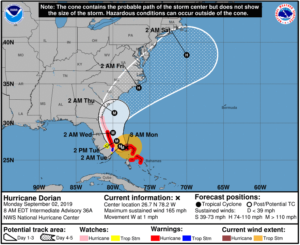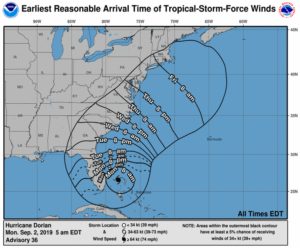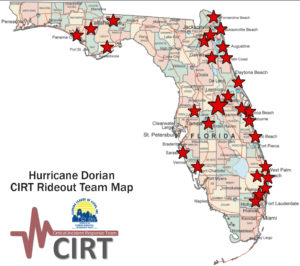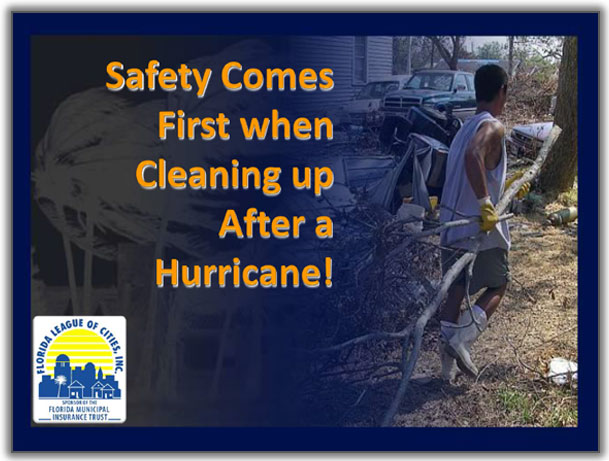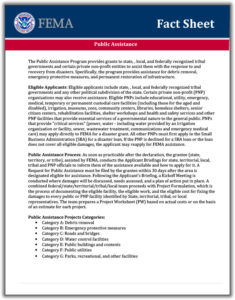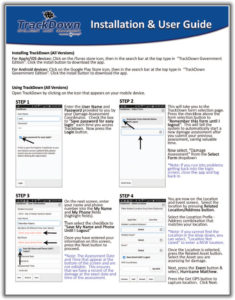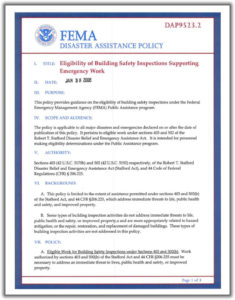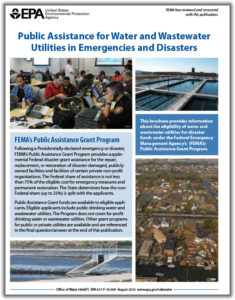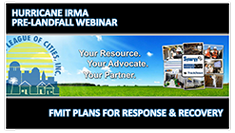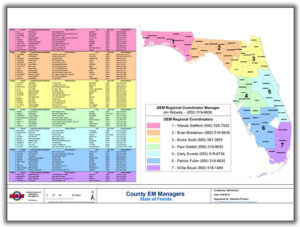There are no impending weather events at this time.
FMIT Alert:
Hurricane Irma Recovery Update
3+ Weeks from Landfall
-
Members who have not reported damages or had Damage Assessments performed, should report any and all damages to Member-owned property caused by Irma to FMIT as soon as possible.
-
The period for receiving a complimentary Damage Assessment of known damages to your insured assets is coming to an end. The purpose of these assessments is to document the post-loss condition of damaged assets. While not a formal adjustment, these assessments streamline the assigning of an adjuster and are used for reporting damages to insurance and documenting for potential Public Assistance purposes. Email irma@flcities.com to request a Damage Assessment along with a list of damaged locations/assets for us to review.
-
Alternatively, you can email irma@flcities.com directly with your claim information related to damaged covered property and covered vehicles. Please note the Damage Assessment method is the most effective and efficient method of claim reporting since it syncs with FMIT’s claims system. Either way your claim-related communications will be addressed as quickly as possible.
-
Adjusters have been visiting Member locations this week as FMIT is currently deploying a state-wide rollout of insurance adjusters.
-
Adjustment teams should be contacting you to schedule your site visits over the coming days.
-
Adjustment teams are focused on visiting losses to buildings and larger structures. Some of these may be at secure facilities, such as water plants. Please ensure the appropriate personnel are available when scheduling site visits..
-
Irma caused widespread minor damages to many scheduled buildings and structures. With the application of the Named Storm Deductible (NSD) as standard part of municipal insurance programs in Florida, for this event deductibles change from the per occurrence P&C deductible (found on the Declarations Page) to the Named Storm Deductible, which is calculated using a percentage (typically 2%, 3%, or 5%) that is multiplied by the scheduled value of each building/structure. In effect, each scheduled asset will have its own deductible.
-
Due to the application of the NSD for wind-related damages, unfortunately many covered member damages to scheduled buildings and structures will fall below the deductible threshold for receiving insurance proceeds.
-
Members will need to manage the recovery of the below-deductible losses assets directly as they would not be eligible for FMIT Turnkey Recovery program unless the Member has a contract with SynergyNDS, Inc. to perform recovery of assets below deductible. This is to protect FMIT Members from potential issues with FEMA public assistance when using a Recovery Program Manager for under-deductible losses.
-
We know that many Members have also experienced damage to Property in the Open (PITO), such as fencing, lighting, playground equipment, etc.
-
Covered PITO is addressed in a special endorsement in the 2016-17 policy. Covered PITO must not be excluded in the PITO Endorsement and must be located at a scheduled location in the policy.
-
Damages to PITO covered under the Endorsement are subject to a PITO sublimit (found on the Dec Page of the FMIT Policy) with a minimum limit of $100,000 per Member).
-
The named storm deductible for PITO is triggered when damage amounts to all covered real property (building, structures, property in the open) exceed the Member’s P&C Deductible for Real Property (found on the Dec Page of the FMIT Policy). Once triggered, the PITO deductible is calculated by multiplying the Named Storm Deductible Percentage in your Named Storm Deductible Endorsement (typically 2% ,3% or 5%) by the actual recovery cost of the covered PITO damages.
-
Example: Member P&C Deductible is $25,000 and NSD is 3%
-
Assume: Damage to scheduled buildings/structures > $25,000
-
Assume: Covered PITO damages of $50,000
-
PITO Deductible: 3% multiplied by $50,000 = $1,500
-
FMIT Anticipated Proceeds: $50,000 – $1,500 = $48,500 (97%)
-
While most PITO is included in the Endorsement, the following assets are not covered and would need to be scheduled separately in the Real & Personal property schedule in order to receive coverage:
-
Signs & Scoreboards (excl. signs attached to buildings)
-
Pavilions & Shade Structures
-
Non-Fixed Assets (portable shade structures, trash cans, etc.)
-
Pumps
-
Please review the PITO Endorsement for more information
-
When repairing covered PITO damages, ensure that you are documenting a photo of the damages and keeping track of all costs incurred by your organization (overtime hours for salaried staff, hourly rates paid to subs, invoices for repairs, etc…) as these will need to be submitted to FMIT for reimbursement.
-
While much of the damage caused by Irma is covered under the FMIT policy, most of Irma’s damage to Member buildings and larger structures will fall well below the Named Storm Deductibles triggered when Irma made landfall as a named storm in Florida.
-
Members can apply for reimbursement for repairs to these damages by applying for federal public assistance through the Federal Emergency Management Agency (FEMA).
-
Members need to ensure that they are following their internal procurement procedures for making repairs to damages assets. If Members’ internal procurement procedures prior to Irma include expedited processes for critical assets damaged due to catastrophic events, those will likely be respected by FEMA.
-
The first step in applying for FEMA Public Assistance is to go to www.floridapa.org and apply. Follow the instructions and fill out the information in order to register in the system.
-
FEMA has a site that answers commonly asked questions located at: https://www.fema.gov/public-assistance-frequently-asked-questions
-
FEMA is currently busy responding to 3 major disasters (Harvey-TX, Irma-FL, Maria-PR). FMIT anticipates that this will somewhat delay the process. Once Members begin scheduling their Kick-Off meetings, they should notify FMIT using the propclaim@flcities.com email.
-
Many Members are facing issues related to debris removal. In nearly all cases, debris from trees or any vegetation knocked over or damaged by the storm is not covered under the FMIT Property Policy unless the debris is either:
a) contacting an insured asset, or
b) blocking immediate access to an insured asset & impeding recovery. -
Any Members that have or are seeking a debris management contractor should ensure that your agreements with said contractor include verbiage that indemnifies and remunerates your organization specifically from errors made by the contractor during the debris management process that would disqualify your organization from FEMA Public Assistance. We also strongly suggest you consult with your organization’s attorney prior to any procurement to assure compliance with any existing or emergency orders or directives applicable to debris removal, FEMA funding or the like.
-
We have been getting requests regarding Member trees that have fallen on citizens’ homes/property. In these cases, FLC will have to determine if the tree was dead or otherwise in a poor condition before rendering a coverage decision. In most cases this is an “act of God” that would not be the fault of the FMIT Member. It is the homeowner’s responsibility to remove the fallen trees on their property and to mitigate additional damages. Homeowners can be advised to file a claim with their homeowner’s insurance company.
-
This is a very popular question among FMIT Members. Through the FMIT PACT (Public Assistance Closeout Team), we have worked with FEMA and Members on previous de-obligations from ‘04/’05 storms as well as recent Hurricanes Hermine and Matthew. We will be supporting Member FEMA PA Applications and associated project worksheet development, where requested, in order to minimize potential issues. We will work with the FEMA PAC specialist to review the project worksheet to ensure that there is no potential duplication of benefits and that the claim has been adjudicated correctly. Information is already being captured in simpliCity under each Member’s claim to assist in the documentation process.
-
Please Ensure That Recovery Operations Are Undertaken Safely. Click Here to download an Overview of Post Event Safety.
-
FMIT will analyze coverage on every claim presented and render an adjudication and settlement for covered damages. FMIT recognizes that as owners of your property, you have the right to undertake repairs to your property as quickly as possible. If you begin repairing/replacing damaged assets, you must ensure that you first have a Damage Assessment performed or assure photos and descriptions of the damages are recorded and transmitted to nate@flcities.com. Without this information, your property damage claim may be jeopardized.
-
Report any and all damages to Member-owned property caused by Nate.
-
The best way to report damages is through the Trackdown Damage Assessment mobile application as damages are linked to existing assets and claims with photos and descriptions. FMIT offers free Damage Assessments to Members who request them and provide a list of damaged locations for us to visit. Email propclaim@flcities.com to request a Damage Assessment along with a list of damaged locations/assets for us to review. These Damage Assessments will also allow us to direct resources to your affected locations.
-
Alternatively, you can email nate@flcities.com directly with your claim information related to damaged covered property and covered vehicles. Please note the Damage Assessment method is the most effective and efficient method of claim reporting since it syncs with FMIT’s claims system. Either way your claim-related communications will be addressed a quickly as possible.
-
If you have reported damages to covered property to FMIT, we will deploy an adjuster to your affected location(s). An adjuster will contact you to schedule the site visit as they are assigned by FMIT.
-
Some Members are facing issues related to debris removal. In nearly all cases, debris from trees or any vegetation knocked over or damaged by the storm is not covered under the FMIT Property Policy unless the debris is either:
a) contacting an insured asset, or
b) blocking immediate access to an insured asset & impeding recovery. -
Any Members that have or are seeking a debris management contractor should ensure that your agreements with said contractor include verbiage that indemnifies and remunerates your organization specifically from errors made by the contractor during the debris management process that would disqualify your organization from FEMA Public Assistance. We also strongly suggest you consult with your organization’s attorney prior to any procurement to assure compliance with any existing or emergency orders or directives applicable to debris removal, FEMA funding or the like.
-
We have been receiving questions regarding Members’ trees that have fallen on citizens’ homes/property. In these cases, FLC will have to determine if the tree was dead or otherwise in a poor condition before rendering a coverage decision. In most cases this is an “act of God” that would not be the fault of the FMIT Member. It is the homeowner’s responsibility to remove the fallen trees on their property and to mitigate additional damages. Homeowners can be advised to file a claim with their homeowner’s insurance company.
-
We don’t anticipate FEMA being a big actor in the Nate recovery. If Public Assistance is available to members, the FMIT can support Member FEMA PA Applications and associated project worksheet development, where requested, in order to minimize potential issues. We will work with the FEMA PAC specialist to review the project worksheet to ensure that there is no potential duplication of benefits and that the claim has been adjudicated correctly. Information is already being captured in simpliCity under each Member’s claim to assist in the documentation process.
-
If applicable, Members are advised to contact SynergyNDS, Inc. (FMIT PACT Manager) after they have scheduled their individual FEMA Kickoff meeting. Synergy is currently setting up additional contact information for the FMIT PACT Team, which will be distributed in subsequent FMIT Alert emails.
Damage Reporting Options (Updated with Lessons Learned through Irma):
-
Call 844-FMIT-CAT (844-364-8228) to request Damage Assessments for your affected locations. FMIT learned through Irma that the Damage Assessment process offered through FMIT is the fastest way to identify and report damages to FMIT. Once you receive reports of initial damages, if any, FMIT will deploy personnel to your organization to capture those losses using Trackdown, FMIT’s proprietary Damage Assessment mobile application.
-
You can also choose to perform your own Damage Assessments using Trackdown. You can go to the Google PlayStore (for Android Devices) or the Apple AppStore (for Apple devices) and search for, “Trackdown – Government Edition” and install it on your device(s). FMIT will be sending out Trackdown login information to Members in the potentially affected area over the next 48 hours.
-
Alternatively you can go online: http://insurance.flcities.com and login to your account and submit your loss notice(s). While FMIT and Synergy are immediately notified of your loss submittal, it may delay the response and recovery process as the loss information for each asset is not captured automatically into our system.
-
While not encouraged due to the increased processing time for Members and FMIT, Members can email damages due to Nate to nate@flcities.com. This may increase the processing time for your claim as this information will need to be entered into simpliCity manually.
Latest from the National Hurricane Center:
“Hurricane Nate is centered near 24.5N 87.0W at 07/0900 UTC or
about 297 nm south-southeast of the mouth of the Mississippi
river. Nate is moving north-northwest at 19 kt. Estimated minimum
central pressure is 987 mb. Maximum sustained wind speed is 70 kt
with gusts to 85 kt. Numerous strong convection is from 23N-25N
between 85W-88W. Scattered moderate to isolated strong convection
and tstms are elsewhere from 17N-29N between 82W-92W.”
FMIT Alert Level 5: High
Dorian Remains Powerful CAT 5 Major Hurricane With MSW of 165 MPH Almost Completely Stalled Out at 1MPH Over The Bahamas.
Models Beginning to Become More Consistent That The Eye of Dorian Will Remain Off The Coast as Dorian Takes It’s Turn to The North.
Latest Projections Continuing to Show Dorian Decreasing in Intensity Over Next 48 Hours Into Category 3 or 4 Hurricane as it Begins to Move North.
Previous Webinar Slides & This Morning’s Webinar Registration Link Below.
FMIT Discussion:
-
As of this morning, Dorian is still a powerful CAT 5 Major Hurricane with wind speeds decreasing slightly to 165 MPH. Majority of models continuing to be in agreement of Dorian curving up before reaching Florida and grazing the Eastern Florida coast.
-
Dorian’s movement speed has now slowed to basically a literal stall over the Bahamas with Western movement at a mere 1 MPH.
-
The exact time that Dorian makes the North turn and then Northeastern turn is critical to whether or not the Eastern Florida coast will see catastrophic damage or only feel the impacts of the outer bands of Dorian.
-
A Hurricane warning is currently in effect for the East coast of Florida from Jupiter Inlet to the Volusia/Brevard County line. A storm surge warning has also been issued from Lantana to the Volusia/Brevard County line. These warnings include Melbourne.
-
FMIT Will be holding a final Pre-Landfall Webinar this for Dorian morning at 11AM. Use the link below to register:
Dorian Pre-Event Webinar – Monday 09/02 11AM EST
https://attendee.gotowebinar.com/register/3417106618467464972Previous Webinar slides are available for download by clicking below:
Click Here To Download Webinar Side Deck
FMIT Ride-Out Teams:
-
Based upon the information available to us at this time, FMIT has deployed Ride-Out Teams and has staged them in the potentially affected areas.
-
Ride-Out Teams are unique to FMIT and their purpose is to have FMIT representatives on the ground prior to the event in order to meet with Member Emergency Management personnel and assist in the performance of damage assessments post-event on their scheduled buildings and larger structures, starting with assets each Member designates as critical.
-
FMIT has been making calls to Members to ensure we have the proper expectations and contact information necessary to make Ride-Out assignments and communicate after the storm.
-
Please take 5 minutes and review the video below to better acquaint yourself with the level of response & recovery support provided to FMIT Members.
FMIT Member Preparedness Actions:
-
Members should continue to monitor the system as well as FMIT Alerts and local/national weather forecasts.
-
Members should implement internal Emergency Response Plans for the protection of citizens and property.
-
Members should begin implementing mitigation measures, including streets, roads and drains maintenance to reduce possible flooding changes, vegetation maintenance to remove potentially at-risk trees, and protective measures for buildings and other structures, including installing storm shutters and removing shade structures and other items susceptible to wind damage.
-
If you do not currently receive FMIT Alerts and would like to be on the FMIT Emergency contact list, click the red button below and fill out the necessary information to subscribe.
Latest Update From The NHC:
“At 800 AM EDT (1200 UTC), the eye of Hurricane Dorian was located by
NOAA Doppler radar near latitude 26.7 North, longitude 78.2 West.
Dorian is moving toward the west near 1 mph (2 km/h). A slow
westward to west-northwestward motion is forecast during the next
day or so, followed by a gradual turn toward the northwest and
north. On this track, the core of extremely dangerous Hurricane
Dorian will continue to pound Grand Bahama Island through much of
today and tonight. The hurricane will move dangerously close to the
Florida east coast tonight through Wednesday evening.
Maximum sustained winds are near 165 mph (270 km/h) with higher
gusts. Dorian is a category 5 hurricane on the Saffir-Simpson
Hurricane Wind Scale. Although gradual weakening is forecast,
Dorian is expected to remain a powerful hurricane during the next
couple of days.“
Hurricane
Dorian
Current Atlantic Tracking Map

Damage Reporting Options:
-
For Immediate Assistance, Call 844-FMIT-CAT (844-364-8228) to report any losses to your insured property and activate the FMIT Turnkey Recovery program for immediate response to any property losses you may have incurred. Also:
-
Go online: http://insurance.flcities.com and login to your account and submit your loss notice(s). FMIT and Synergy are immediately notified of your loss submittal.
County Emergency Managers List – For additional contact information about your county, please Click Here.Storm Response Safe Work Practice – To Download, please Click Here.In order to assist us further, we have provided a simple way to let us know if you have damages to your property.
If you have damages and have not yet received assistance on behalf of FMIT, please click the button below. Someone will be contacting you within 1 hour to review with you.
FEMA Public Assistance
Fact SheetTrackDown Application
Installation & User GuideFEMA PA Fact Sheet Eligibility
of Building Safety Inspections
Supporting Emergency WorkFMIT ALERT RATING SYSTEM
FMIT ALERT
RATING SYSTEM
In order to give Members a clearer decision path for responding to alerts, FMIT will begin using a new alert rating system. The rating system will be based upon a combination of data that takes into account the following factors with regard to a weather event: Current NOAA Data, Relative Proximity to Florida and Predicted Path & Intensification Data from various sources. We will use a 5-number rating system in ascending order of intensity (similar to how hurricane intensity is rated) in order to help you determine how you should respond to alert information. The numbering system will work as follows:
LEVEL 1LOWAlert will provide information to FMIT Members in the entire state of Florida. This level will provide information about tropical weather with a very low potential of affecting Florida within 7 days. This will include tropical waves with a low chance of development as well as tropical storms and hurricanes that are 7+ days away from Florida with a very small chance of affecting Florida based upon NOAA and model predictions*. These alerts may also include other weather events that Members should be aware of, but for which Members should not have direct, immediate concern.*In some cases, we may decide to withhold Level 1 alerts for tropical events developing in areas that have little-to-no immediate potential for impacting Florida.Member Response: AwarenessLEVEL 2LOW-MODERATEAlert will provide information to FMIT Members in the entire state of Florida. This level will provide information about tropical weather with a low-moderate potential of affecting Florida within 5 days. This will include tropical waves with a moderate chance of development as well as tropical storms and hurricanes that are 5 days away from Florida with a low-moderate chance of affecting Florida based upon NOAA and model predictions*. These alerts may also include other weather events that Members should be aware of, but for which Members should not have direct, immediate concern.*In some cases, we may decide to withhold Level 2 alerts for tropical events developing in areas that have little-to-no immediate potential for impacting Florida.Member Response: Awareness & Limited Action (Possible communication with internal Disaster Preparedness Team Members as to Knowledge of Weather Event)LEVEL 3MODERATEAlert will provide information to FMIT Members in the entire state of Florida. This level will provide information about tropical weather with a moderate potential of affecting Florida within 3-5 days. This will include tropical waves with a moderate-high chance of development as well as tropical storms and hurricanes that are 3-5 days away from Florida with a moderate chance of affecting Florida based upon NOAA and model predictions. These alerts may also include other weather events that Members should be aware of with moderate concern.Member Response: Awareness & Action with Stakeholders (Potential implementation of Disaster Preparedness Plans)LEVEL 4MODERATE-HIGHAlert will provide information to all FMIT Members within and in the vicinity of the 5-Day Forecast Cones issued by NOAA. This level will provide information about Tropical Storms and Hurricanes with a potential to impact parts of Florida within 24 hours. These alerts will come in with the “High Priority” setting in Microsoft Outlook used to alert Members of the importance of the email. After a Level 4 Alert, Members in the 5-Day Forecast Cones will receive communications from the FMIT Recovery Program Manager in order to ensure that the following are reviewed: Emergency Contacts, Critical Assets, Member Expectations/Requirements, Pre-Staging of Assets, etc…Member Response: Awareness, Implementation of Disaster Preparedness Plans, Communications with FMIT Recovery Program Manager (Members should be actively preparing for the possibility of an event in their area)LEVEL 5HIGHAlert will provide information to all FMIT Members in the potential 3-Day/5-Day Forecast Cones issued by NOAA. This level will provide information about Tropical Storms and Hurricanes with a potential to impact Florida within 1-3 days. These alerts will come in with the “High Priority” setting in Microsoft Outlook used to alert Members of the importance of the email. After a Level 5 Alert, Members in the Forecast Cones will receive communications from the FMIT Recovery Program Manager in order to finalize disaster preparations, contact Emergency Contacts, confirm pre-staging of Assets and FMIT Rapid Damage Assessment personnel, establish Post-Event Meeting Locations, etc…Member Response: Awareness, Execution of Disaster Preparedness Plans, Communications with FMIT Recovery Program Manager (Members should be making final preparations for the possibility of an event in their area)Click on the Following FEMA Public Assistance FACT SHEETS Along With Other Materials for Additional Information to Support Your Response & Recovery Initiatives:

